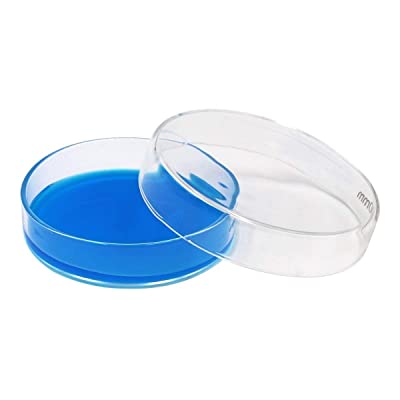Borosilicate 3.3 Glass Petri Dish With lid
Catalog No :
CAS Number :
Brand :
In Stock
Specifications:
| Application | Cell culture, Microbiology, sterilization |
| Material | Borosilicate glass |
| Storage Temperature | Room Temperature |
| Product Type | Dish |
| Product Brand | JoanLab |
| Product Grade | Laboratory grade |
Borosilicate 3.3 Glass Petri Dishes are premium, reusable laboratory dishes designed for various microbiological, cell culture, and chemical applications. These dishes, made from high-quality borosilicate 3.3 glass, are resistant to thermal shock, chemical corrosion, and mechanical stress, making them ideal for robust laboratory use.
Product Description
- Material:
- Constructed from borosilicate 3.3 glass, known for its superior durability and resistance to thermal and chemical stress.
- Non-porous surface ensures easy cleaning and sterilization, maintaining sterility for microbiological applications.
- Design:
- Two-piece design: a shallow base and a slightly larger lid.
- Lid fits snugly over the base, protecting the culture environment while allowing gas exchange.
- Dimensions:
- Available in various diameters (e.g., 90 mm, 100 mm, 150 mm) to accommodate different experimental needs.
- Transparency:
- Crystal-clear glass allows for precise observation of microbial growth, colony morphology, or chemical reactions without removing the lid.
- Thermal and Chemical Resistance:
- Can withstand high temperatures (up to 150°C) and is resistant to most laboratory chemicals, including acids, alkalis, and solvents.
- Sterility:
- Reusable design allows for repeated sterilization via autoclaving, dry heat, or chemical disinfectants.
Key Features
- High Durability:
- Borosilicate 3.3 glass ensures resistance to thermal shock, making it ideal for high-temperature applications such as autoclaving and dry heat sterilization.
- Non-Porous Surface:
- Prevents absorption of chemicals or microbial residues, ensuring consistent sterility and reproducibility.
- Reusable and Eco-Friendly:
- Unlike disposable plastic dishes, these petri dishes are reusable, reducing laboratory waste and costs.
- Stable Design:
- Flat bottom for stability during use and stacking.
- Gas Exchange:
- Lid design allows controlled airflow, essential for microbial growth while minimizing contamination.
Applications
- Microbiology:
- Cultivation and isolation of bacteria, fungi, and other microorganisms.
- Ideal for streaking agar plates or observing colony morphology.
- Cell Culture:
- Can be used for tissue culture, plant propagation, or small-scale cell line experiments.
- Chemical and Analytical Testing:
- Suitable for holding small volumes of liquids or solids during chemical reactions.
- Can be used for crystallization or evaporation processes.
- Pharmaceutical Quality Control:
- Sterility testing of pharmaceutical products or environmental monitoring.
- Environmental Studies:
- Testing soil, water, and air samples for microbial or chemical contaminants.
- Academic Use:
- Perfect for teaching microbiological techniques and experiments in educational institutions.
Advantages
- Thermal and Chemical Resistance:
- Withstands harsh conditions, including autoclaving, exposure to strong acids, and high-temperature drying.
- Enhanced Visibility:
- Crystal-clear glass enables detailed observation of cultures without disturbing the growth environment.
- Long Lifespan:
- Reusable nature reduces long-term costs compared to disposable plastic dishes.
- Versatile Applications:
- Compatible with a wide range of laboratory processes, from microbial cultivation to chemical testing.
- Eco-Friendly:
- Reduces plastic waste by offering a sustainable, reusable alternative.
Specifications
| Property | Details |
|---|---|
| Material | Borosilicate 3.3 Glass |
| Thermal Resistance | Up to 150°C |
| Chemical Resistance | High, against acids, alkalis, and solvents |
| Diameter | 90 mm, 100 mm, 150 mm (options available) |
| Reusability | Fully reusable and autoclavable |
| Transparency | Crystal-clear for high visibility |
| Packaging | Individually packed or grouped in sets |
Care and Maintenance
- Cleaning:
- Wash with neutral detergents and soft brushes to prevent scratches.
- Avoid abrasive materials to maintain optical clarity.
- Sterilization:
- Autoclave at 121°C for 15–20 minutes.
- Dry heat sterilization at temperatures up to 250°C.
- Use chemical disinfectants if necessary, ensuring thorough rinsing afterward.
- Storage:
- Store in a clean, dry environment to prevent contamination.
- Handle with care to avoid chips or cracks.
Comparison to Plastic Petri Dishes
| Feature | Borosilicate Glass Petri Dishes | Plastic Petri Dishes |
|---|---|---|
| Reusability | Reusable | Single-use |
| Material | Borosilicate Glass | Polystyrene or other plastics |
| Chemical Resistance | High | Moderate to Low |
| Thermal Resistance | Up to 150°C | Limited |
| Environmental Impact | Eco-friendly | Generates plastic waste |
| Cost | Higher upfront cost | Lower initial cost |
The Borosilicate 3.3 Glass Petri Dishes with Lids are indispensable for laboratories requiring high durability, chemical resistance, and precision. Their reusability makes them a cost-effective and environmentally friendly alternative to disposable plastic petri dishes, suitable for a wide range of applications in microbiology, chemistry, and environmental sciences.
- Size: Ø: 60 x 15mm Ø: 90 x 15mm Ø: 75 x 15mm Ø: 100 x 20mm




 0
0
